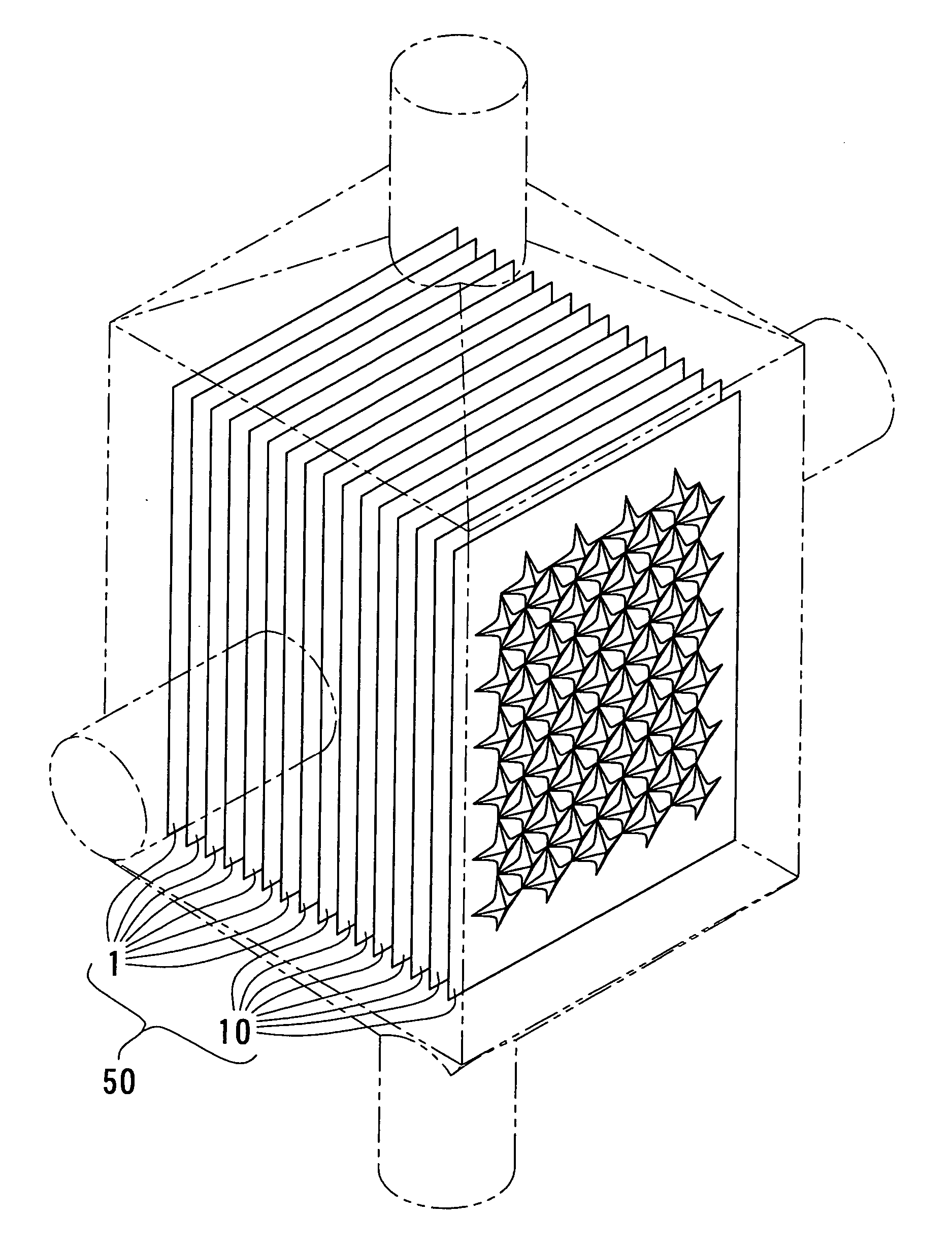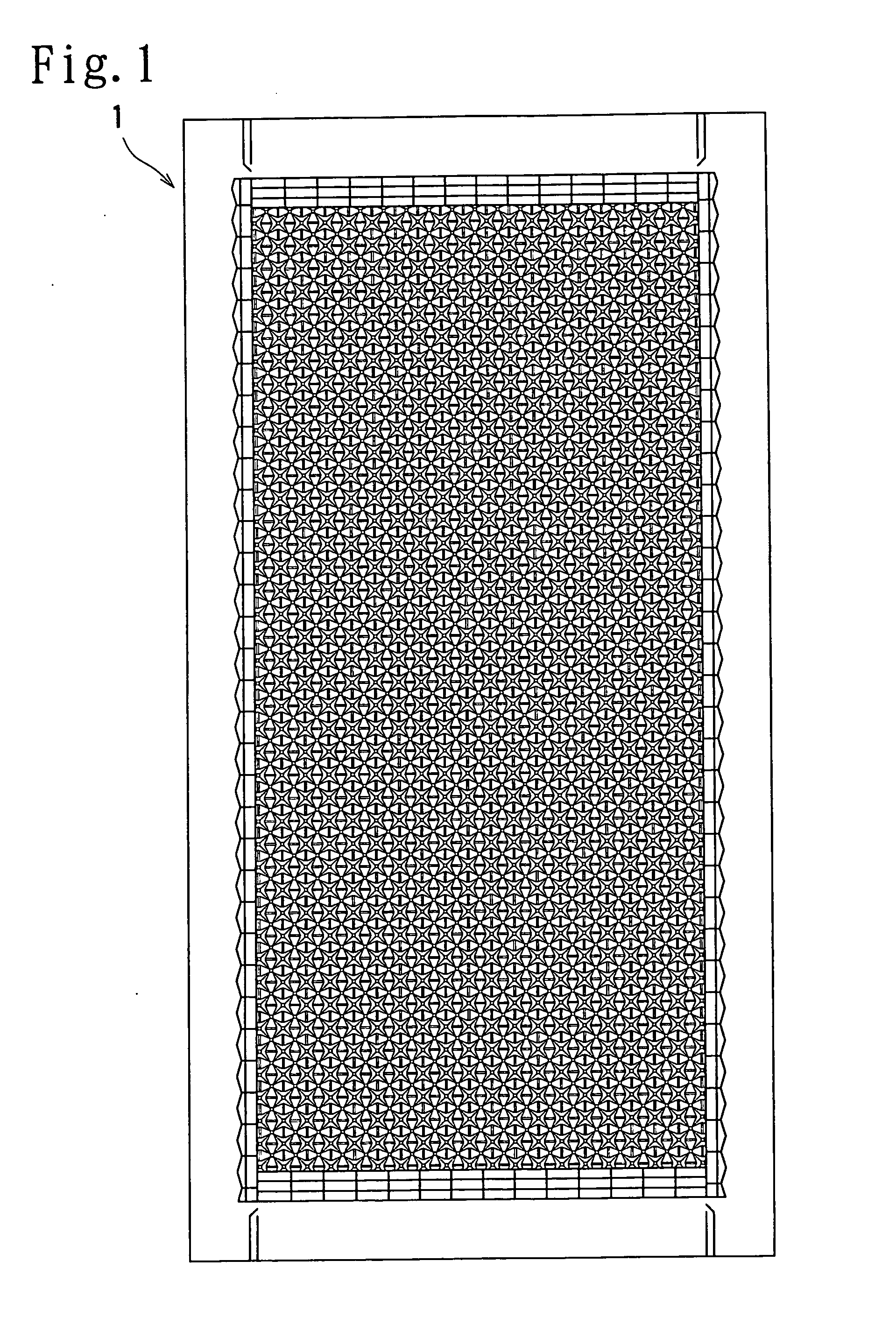Plate for heat exchange and heat exchange unit
a technology of heat exchange and heat exchange unit, which is applied in the direction of lighting and heating apparatus, laminated elements, and stationary conduit assemblies, etc., can solve the problems of deteriorating heat transfer performance, unfavorable variation in the distance between the plates, and the use of heat exchange fluid, etc., to achieve sufficient heat transfer performance relative, excellent heat transfer property, and flexible use
- Summary
- Abstract
- Description
- Claims
- Application Information
AI Technical Summary
Benefits of technology
Problems solved by technology
Method used
Image
Examples
first embodiment
of the Present Invention
[0033] Now, the first embodiment of the present invention will be described in detail below with reference to FIGS. 1 to 5(B). FIG. 1 is a schematic structural view of a heat exchange plate according to the first embodiment of the present invention. FIG. 2 is an enlarged plan view of an essential structure of the heat exchange plate according to the first embodiment of the present invention. FIG. 3(A) is a cross-sectional view cut along the line A-A in FIG. 2, FIG. 3(B) is a cross-sectional view cut along the line B-B in FIG. 2 and FIG. 3(C) is a cross-sectional view cut along the line C-C in FIG. 2. FIG. 4(A) is a cross-sectional view cut along the line D-D in FIG. 2 and FIG. 4(B) is a cross-sectional view cut along the line E-E in FIG. 2. FIGS. 5(A) and 5(B) are descriptive views illustrating gaps formed between a pair of combined heat exchange plates according to the first embodiment of the present invention and the other gaps formed between the other pair...
second embodiment
of the Present Invention
[0044] Now, the second embodiment of the present invention will be described in detail below with reference to FIGS. 6 and 7. FIG. 6 is a schematic structural view of a heat exchange plate according to the second embodiment of the present invention. FIG. 7 is a descriptive view illustrating a flow of a heat exchange fluid in the combined heat exchange plates according to the second embodiment of the present invention.
[0045] As shown in FIGS. 6 and 7, the heat exchange plate 10 according to the second embodiment of the present invention has the pattern of irregularities with the main protrusions 11 and the intermediate protrusions 12 in the same manner as the above-described first embodiment of the present invention. However, the heat exchange plate 10 according to the second embodiment differs from the first embodiment in that the ridgelines 14 of the main protrusions 11 extend in parallel with or perpendicular to the side edges of the heat exchange plate 10...
third embodiment
of the Present Invention
[0051] Now, the third embodiment of the present invention will be described in detail below with reference to FIG. 11. The third embodiment describes a heat exchange unit into which the above-described heat exchange plates of the present invention are assembled so as to be placed in parallel with each other. FIG. 11 is a schematic structural view of the heat exchange unit according to the third embodiment of the present invention.
[0052] As shown in FIG. 11, the heat exchange unit 50 has a structure in which a predetermined number of the first heat exchange plates according to the first embodiment and a predetermined number of the second heat exchange plates according to the second embodiment are combined with each other. More specifically, the first heat exchange plates each having the pattern of irregularities in which the ridgelines 2b of the main protrusions 2 intersects any one of the sides of the plate having the rectangular shape at an angle of 45 degr...
PUM
 Login to View More
Login to View More Abstract
Description
Claims
Application Information
 Login to View More
Login to View More - R&D
- Intellectual Property
- Life Sciences
- Materials
- Tech Scout
- Unparalleled Data Quality
- Higher Quality Content
- 60% Fewer Hallucinations
Browse by: Latest US Patents, China's latest patents, Technical Efficacy Thesaurus, Application Domain, Technology Topic, Popular Technical Reports.
© 2025 PatSnap. All rights reserved.Legal|Privacy policy|Modern Slavery Act Transparency Statement|Sitemap|About US| Contact US: help@patsnap.com



